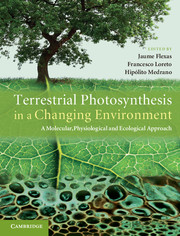 Terrestrial Photosynthesis in a Changing Environment
Terrestrial Photosynthesis in a Changing Environment Book contents
- Frontmatter
- Contents
- List of contributors
- Preface
- Acknowledgements
- List of abbreviations
- 1 Terrestrial photosynthesis in a changing environment
- Part I Photosynthesis
- Part II Measuring photosynthesis
- Part III Photosynthetic response to single environmental factors
- Part IV Photosynthesis in time
- Part V Photosynthesis in space
- 26 Whole-plant photosynthesis: potentials, limitations and physiological and structural controls
- 27 Ecophysiology of photosynthesis in the tropics
- 28 Ecophysiology of photosynthesis in desert ecosystems
- 29 Ecophysiology of photosynthesis in semi-arid environments
- 30 Ecophysiology of photosynthesis in temperate forests
- 31 Ecophysiology of photosynthesis in boreal, arctic and alpine ecosystems
- 32 Crop photosynthesis
- Part VI Photosynthesis in a global context
- References
- Index
27 - Ecophysiology of photosynthesis in the tropics
Published online by Cambridge University Press: 05 March 2013
- Frontmatter
- Contents
- List of contributors
- Preface
- Acknowledgements
- List of abbreviations
- 1 Terrestrial photosynthesis in a changing environment
- Part I Photosynthesis
- Part II Measuring photosynthesis
- Part III Photosynthetic response to single environmental factors
- Part IV Photosynthesis in time
- Part V Photosynthesis in space
- 26 Whole-plant photosynthesis: potentials, limitations and physiological and structural controls
- 27 Ecophysiology of photosynthesis in the tropics
- 28 Ecophysiology of photosynthesis in desert ecosystems
- 29 Ecophysiology of photosynthesis in semi-arid environments
- 30 Ecophysiology of photosynthesis in temperate forests
- 31 Ecophysiology of photosynthesis in boreal, arctic and alpine ecosystems
- 32 Crop photosynthesis
- Part VI Photosynthesis in a global context
- References
- Index
Summary
Introduction
The ‘tropics’ are the most diverse and productive ecosystems on earth. They are broadly defined as those ecosystems that lie between 23.4° N and S latitude. The development of tropical ecosystems as we know them occurred shortly after the rise to dominance of angiosperms and coincided with the diversification of many angiosperm lineages. During this period, between 100 and 36 MA, warm paleoclimates supported much larger areas of tropical vegetation globally. Tropical forests were found not only in equatorial regions but also in mid latitudinal bands north and south of subtropical arid belts (Morley, 2000). Tropical climates are broadly characterised as having more diurnal than seasonal variation in temperatures, but often large seasonal variations in rainfall. Within the tropics, ecosystems range from hot, humid-lowland wet-tropical rain forests to cold, dry high-alpine paramos. Figure 27.1, for example, shows 30-year monthly means for temperature and precipitation for four stations within 1°C of the equator. The Kenyan station had the greatest temperature variations, but even then, the range was only 4°C. Izobamba, Ecuador, at 3050 m elevation, was nearly 15°C cooler than the other sites. Rainfall totals varied eightfold between Garissa, Kenya and Padang, Indonesia, and even within Indonesia precipitation varied by 40% between the sites.
Although tropical plants face similar basic ecophysiological challenges to those in non-tropical ecosystems, the tropics are unique in the sheer diversity of species and life forms and the general lack of freezing temperatures (except in high-mountain ecosystems). In this chapter, we will concentrate our discussion on three major types of tropical environments (wet tropical forests, savannas and mangroves). In each ecosystem, we explore major areas of research related to the ecophysiology of photosynthesis.
- Type
- Chapter
- Information
- Terrestrial Photosynthesis in a Changing EnvironmentA Molecular, Physiological, and Ecological Approach, pp. 424 - 434Publisher: Cambridge University PressPrint publication year: 2012


